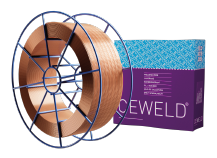Should we weld S690 steel with fluxcored or solid wire ?
Offshore requirements for welding S690 steels are usually under supervision of DNV, Lloyds, Bureau Veritas and ABS because they have created a set of rules with minimum requirements to grand safety in the construction. In general, these rules are pretty much the same but require lots of experience to meet in practice.
| Tensile strength | > 770 MPa |
| Yield strength | > 690 MPa |
| Elongation | > 17% |
| Impact at -40°C | > 69 Joule |


Rutile cored wire CEWELD AA R690
We all know that flux cored wires are preferred by the welders due to the smooth arc and the wider spray arc range. As rule of thumb, we can say that the flux cored wire shows excellent weldability from 180 till 270 ampere. Another nice thing about flux cored wires is the possibility to add a slag system to support high currents in Position (typical 240 Ampere in PF position against 120 Ampere with a solid wire).

Metal cored wire (MCAW) CEWELD AA M690
For the metal cored wire the main benefit to consider is the deposition rate that is 10-20% higher than solid wire due to the fact that powder melts more easily than the solid wire and results in improved current density. Metalcore wire also promotes wetting that allows higher travel speeds and makes it easier to fulfill the required T8-5 times that are crucial for S690.
- Large constructions often can hardly be turned to create a down-hand welding position.
- Offshore quality requirements are much higher and not easy to fulfill with solid wires
- Flux-cored wires still create fewer bonding failures
- Most solid wires do not have the required offshore approvals such as DNV and Lloyds.
- Higher deposition and productivity (200% for positional welding / 120% for down hand)
- Increases duty cycle of the welder by at least 5% due to the lovely arc
